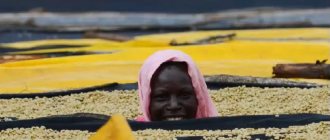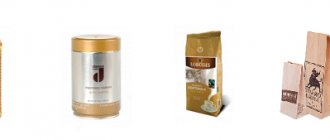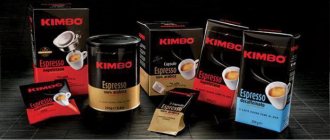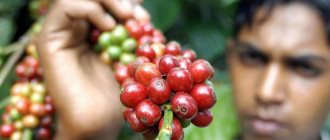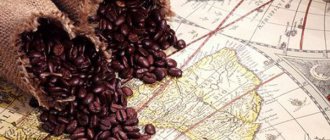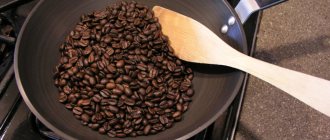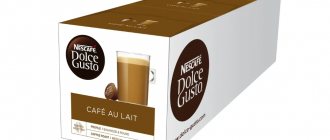Let's say you returned from Turkey and, on the advice of bloggers, bought a bag/jar of Turkish coffee under the Mehmet Efendi brand as a souvenir. And then the question arose: how to brew Turkish coffee.
From my last trip I brought coffee only in this packaging.
We arrived, cooked it in a Turk, but it was tasteless and bitter - you are at a loss, why are the Turks crazy about it?
Brand history
The company began its work at the end of the 19th century. At that time, only green coffee beans were sold throughout Turkey. People bought them and roasted them at home, just before cooking. A man named Mehmet Efendi decided to try roasting the beans himself and offer them for sale ready-to-eat (see types of roasting coffee beans). How the popular coffee company was born.
The business was continued by your sons Mehmet. By the 30s of the next century, their family received the surname Kurukahveci. By this time the company had already grown considerably. They began supplying products abroad, popularizing Turkish coffee (see Oriental coffee recipe), speaking at various exhibitions and events.
The factory is still located in its homeland - Istanbul. And the company is now managed by the fourth generation of the Efendi family.
Today, the geography of supplies includes more than 50 countries around the globe.
Dishes and serving
Turkish coffee is served in Turkish cups. They can also drink tea from them. There is an old name for such cups. This is filjan. It is a small vessel with a volume of 50 ml, made of porcelain and without a handle. It is often complemented by a metal cup holder with a handle for convenience.
In a more modern presentation, the drink is served in coffee cups and saucers. They must be well preheated. Separately place a sugar bowl with lump sugar and a vessel with cold water. It is considered good form to serve sweets, for example, Turkish delight pinned on a toothpick.
Handmade filjan with embossing
Dishes for Turkish coffee can be porcelain, metal (zinc or copper alloy), or glass. Painted porcelain and metal chasing look very colorful. The most expensive set of dishes can be decorated with stones, gold and silver. To create a complete picture of a Turkish coffee table, you need to purchase a metal tray, saucers for sweets, a vessel for water and spoons with long handles.
How to serve and drink the drink? It is correct to do this after eating. Warmed cups, a vessel with ice water, sugar and sweets are placed on the table. To warm up the dishes, just pour hot water into it and leave for a minute. First, Turkish foam is poured into the cups, and then the drink itself is poured.
You should not drink coffee right away, it is too hot and can burn your lips. You need to pause for 1–2 minutes until the sediment falls to the bottom and begin to slowly drink the drink, exchanging information with your interlocutor. This is how they drink a black drink while having a peaceful conversation in Turkey.
Raw materials and production
To make its products, the company uses Arabica and Robusta beans from different parts of the world. The procurement geography includes Africa, Brazil, Ethiopia and other countries. All raw materials are thoroughly tested and processed, and then fried using modern equipment.
What’s interesting is that in the assortment you can find unique blends in which up to seven varieties of different coffees are mixed. This allows you to achieve an unusual taste of the drink.
Range
When compared with other brands, Mehmet Efendi will have slightly less choice. But in any case, you will find a drink to suit your taste. The assortment includes varieties for export and classic Turkish coffee.
Turkish coffee
Characteristics:
- Composition: 100% Arabica.
- Grinding: ultra-fine (see types of coffee grinding).
In Turkey, they prefer to drink this coffee for breakfast. The drink has a pleasant sourness and a slightly noticeable taste of chocolate. In the aftertaste you will feel spice and hints of fried bread.
Ideal for cooking in a Turk.
Filter Coffee
A mixture of coffee varieties from different parts of the world. Depending on the location and growing conditions, taste qualities vary greatly. This allows you to get unique blends.
- Colombian coffee. A drink with pronounced sourness. Pleasant chocolate shade, aftertaste with fruity notes.
- Ethiopian coffee Mehmet Efendi. The coffee is viscous, with a bright floral aroma. Fruity aftertaste.
- Asiatic. A drink with a slight sourness and a taste of caramel with fried bread. Pleasant aftertaste with notes of spice.
- Guatemala. Average acidity of the finished coffee. Bright fruity taste, delicate aftertaste with floral undertones.
Press Pot
The drink has a very balanced taste and aroma. Pleasant sourness. Premium dark roasted Arabica beans are used for production.
Espresso
An excellent choice for making espresso. A unique blend that includes 7 varieties of coffee. The drink has a viscous structure. The taste combines fruity notes, chocolate and the taste of fried bread. Velvety aftertaste.
Mehmet Efendi does not produce instant coffee. The product line includes only ground and grain.
So, my method is how to brew Turkish coffee
1. Take a typical Turkish brass pot (others are also possible - steel, ceramic, but the cooking time will then be different). I have 100 grams of Turk.
Author's tours in Turkey
This is a trip for those who:
- Doesn't want to spend time on a tourist bus
- Tired of package deals
- Doesn't want to overpay for a vacation
- Wants a vibrant program in a small group

